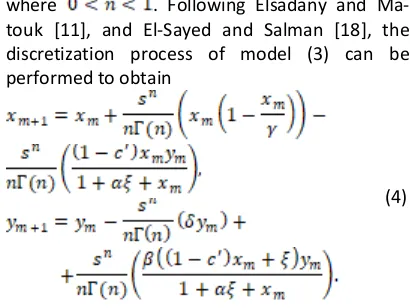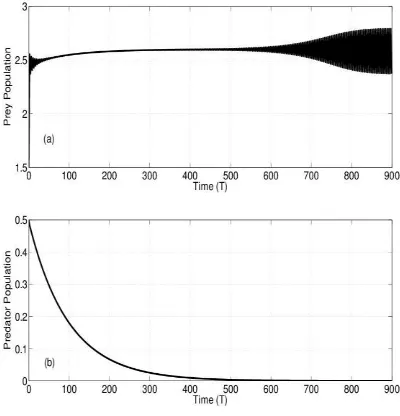Numerical Solution of a Fractional-Order Predator-Prey Model
with Prey Refuge and Additional Food for Predator
Rio Satriyantara, Agus Suryanto
*, Noor Hidayat
Department of Mathematics, Faculty of Mathematics and Natural Sciences, University of Brawijaya, Malang, Indonesia
Abstract
In this paper, a fractional-order predator-prey model with prey refuge and additional food for predator is solved numerically. For that aim, the model is discretized using a piecewise constant arguments. The equilibrium points of the discrete fractional-order model are investigated. Numerical simulations are conducted to see the stability of each equilibrium point. The numerical simulations show that stability of the equilibrium points is dependent on the time step.
Keywords: Additional Food, Fractional-Order, Predator-Prey, Prey Refuge.
INTRODUCTION
In ecology, understanding the dynamical relationship between prey and predator are center of goal [1]. Relationship between prey and predator plays important role for universal existence [2]. In 1928, Lotka [3] and Volterra [4] studied the relationship between prey and predator then introduced a predator-prey model. Recently, Ghosh et al. introduced the following prey-predator model with prey refuge and additional food for predator [5].
(1)
where and denote the density of prey and predator with all parameters are positive. Model (1) explain that prey population grows logistically with environmental carrying capacity . In the second part of right-hand-side the prey population, parameter characterize as predation rate on prey by modified functional respon Holling-type II. The refuge on prey is exhibit in order to avoid the extinction of prey population caused by predation. In present, It is found that refuge shown by barnacle Balanus
glandula (prey) in the higher intertidal stabilizes
its interaction with snails Thais (the predator) [6]. Term be the prey refuge where . Considering the limited resources caused by prey refuge, the predators need alternative food to prolong their survivability or it is known as additional food. For example in real life, in the
Correspondence address:
Agus Suryanto
Email : [email protected]
Address : Dept. Mathematics, Faculty of Mathematics and Natural Science, University of Brawijaya, Veteran Malang, Malang 65145.
Channel Island (archipelago off the French coast), golden eagle Aquila chrysaetos is reduced three resident fox populations by over 95%. The review reported that the A. chrysaetos are primarily sustained by hyper abundant alternative food species, the fox itself [7]. In model (1), the additional food is characterized as with both are quality and quantity of additional food, respectively. Parameter represent the effect of predation, while be the death rate of predator. Solutions of model (1) has to satisfy the positivity condition that is and for all , due to biological nature.
Ghosh et al. showed that model (1) has three equilibrium points [5]: trivial equilibrium point , axial equilibrium point and co-existing equilibrium point with
and .
Systematically, predator-prey model forms a system of first-order differential equations. In recent years, differential equation model with fractional-order atrracted researchers because of its applications in a lot of science areas [8]. Fractional-order differential equation provides excellent instrument for the description of memory and heredity of various materials and processes [9]. As a generalization of integer-order differential equation, the fractional-integer-order exhibit dynamic behaviors, such as period- -orbits [10]. Thus, fractional-order model gives interpretation of real phenomena realistically. Furthermore, the fractional-order model are naturally related to models with memory which exists in most biological models [11,12,13].
(2)
where [14].
Population dynamics model becomes more appropriate and realistic when it is modeled by difference equations. A discretization of fractional-order models is needed because nonlinear fractional-order models generally have no analytical solution expressible in terms of a finite representation of elementary functions [15]. A discrete fractional-order is a something new for scientist. Miller and Ross pioneering this work [16]. The discrete memory effect of the model indicates that the momentum depend on the past information [17].
In this paper, a fractional-order predator-prey model is discussed. Model (1) is then modificated by forming it into a discrete fractional-order with piecewise constant arguments. The aim of this study is to give an overview of population densities based on numerical simulations of the discrete fractional-order model.
MATERIAL AND METHOD Discrete Model
Model (1) is modified into a fractional-order by replacing the first order derivative and
into fractional order derivative and . The modified model (1) is of the form
(3) Euler discretization of model (1).
Determination of the Equilibrium Point
The equilibrium point of the model is obtained when the population growth rate are
zero. The equilibrium point illustrates a constant solution of the model.
Numerical Simulation
Numerical simulations will be performed to study the behavior of model (4). Furthemore, the interpretation of the resulted numerical simula-tions is then discussed. the equilibrium point of model (4) if it satisfies
(5)
Obviously, model (4) has three equilibrium points:
1. The trivial equilibrium point , 2. The axial equilibrium point , and 3. The co-existing equilibrium point
with and
.
Numerical Method and Simulations
To illustrate the model (4), some results of our numerical simulations are provided. The numerical simulations are performed using parameter values as in Table 1.
Table 1. Parameters Value
Parameters
Value
Using parameter values on Table 1, it can be shown that both of equilibrium point
and exist, but equilibrium point does not exist.
population directly goes to extinct. This shows that is asymptotically stable. For a larger (that is ), the numerical solution of prey population is unstable (Fig. 3). Figure 3 show that the prey population oscillates around . In more detail, period- -orbits appeares in prey population.
For next simulation, we still use parameters as in Table 1, except , , , and . Using those parameters, equilibrium point , , and
exist.
Figure 1. Numerical solution using , ,
, , , ,
and for on both (a) prey and
(b) predator population.
Figure 2. Numerical solution using , ,
, , , ,
and for on both (a) prey and (b) predator population.
In Figure 4 and Figure 5, using a relatively small value of s, the numerical solutions of each population are seem to be asymptotically stable and converge to equilibrium point . In Figure 6, a larger value of is chosen. In this case, the solution blows up and is not convergent to any point. This indicates that is unstable with a larger value.
Figure 3. Numerical solution using , ,
, , , ,
and for on both (a) prey and (b) predator population.
Figure 4. Numerical solution using , ,
, , ,
, and for on both
Figure 5. Numerical solution using , ,
, , ,
, and for on
both (a) prey and (b) predator population.
Figure 6. Numerical solution using , ,
, , ,
, and for on
both (a) prey and (b) predator population.
CONCLUSION
In this paper, a discrete fractional-order predator-prey model has been investigated. The discrete model has three equilibrium points, namely the trivial , the axial , and the co-existing equilibrium point. The numerical simulations show that equilibrium point of discrete model may be stable only for relatively small time step . If higher value of is selected, then complex dynamical behavior such as a period- -orbits appeares. In the future, we
will explore the dynamics of the model analytically.
REFERENCES
[1] Ghorai, S., S. Poria. 2016. Pattern formation and control of spatiotemporal chaos in a reaction diffusion prey-predator model supplying additional food. J. Chaos Solitons
Fractals. 85. 57-67.
[2] Pal, D., P. Santra, G.S. Mahaputra. 2017. Dynamical behavior of three species predator-prey model with mutual support between non refuge prey. Ecol. Genet.
Genomics. 3(5). 1-6.
[3] Lotka, A.J. 1925. Elements of physical biology. William and Winlkins. Baltimore. [4] Volterra, V. 1931. Lecons sur la theorie
mathematique de la lutte pour la vie. Gauthier-Villars. Paris.
[5] Ghosh, J., B. Sahoo, S. Poria. 2017. Prey-predator dynamics with prey refuge providing additional food to predator.
Chaos Solitons Fractals. 96. 110-119.
[6] Chakraborty, S., P.K. Tiwari, S.K. Sasmal, S. Biswas, S. Bhattacharya, J. Chattopadhyay. 2017. Interactive effects of prey refuge and additional food for predator in a diffusive predator-prey system. Appl. Math. Model. 47. 128-140.
[7] Gibson, L. 2006. The role of lethal control in managing the effects of apparent competition on endangered prey species.
Wildl. Soc. Bull. 34. 1220–1224.
[8] El Raheem, Z.F., S.M. Salman. 2014. On a discretization process of fractional-order Logistic differential equation. J. Egypt.
Math. Soc. 22. 407-412.
[9] Chen, F., X. Luo, Y. Zhou. 2011. Existence results for nonlinear fractional difference equation. Advances in Difference Equations. ID: 713201.
[10] Ji, Y.D., L. Lai, S.C. Zhong, L. Zhang. 2018. Bifurcation and chaos of a new discrete fractional-order logistic map. Commun.
Nonlinear Sci. Numer. Simulat. 57. 352-358.
[13] Huda, M.N., Trisilowati, A. Suryanto. 2017. Dynamical analysis of fractional-order Hastings-Powell food chain model with alternative food. J. Exp. Life Sci. 7(1). 39-44. [14] Petras, I. 2011. Fractional order nonlinear
models. Higher Education Press, Beijing, and Springer-Verlag. Berlin Heidelberg. [15] Matouk, A.E., A.A. Elsadany, E. Ahmed, H.N.
Agiza. 2015. Dynamical behavior of fractional order Hastings-Powell food chain model and its discretization. Commun.
Nonlinear Sci. Numer. Simulat. 27. 153-167.
[16] Miller, K.S., B. Ross. 1988. Fractional difference calculus. In: Proceedings of the International Symposium on Univalent Functions, Fractional Calculus and Their Applications. Nihon University, Koriyama, Japan. Journal Ellis Horwood Ser. Math.
Appl. Horwood, Chichester 139-152.
[17] Liu, Z., T. Xia. 2017. Novel two dimensional fractional-order discrete chaotic map and its application to image encryption. Appl.
Comput. Informatics. 10.1016/j.aci.2017.07.
002.
[18] El-Sayed, A.M.A., S.M. Salman. 2013. On a discretization process of fractional order Riccati Differential Equation. J. Fract. Calc. Appl. 4(2). 251-259.
[19] Elaydi, S. 2005. An introduction to difference equations, 3rd Ed. Springer.


